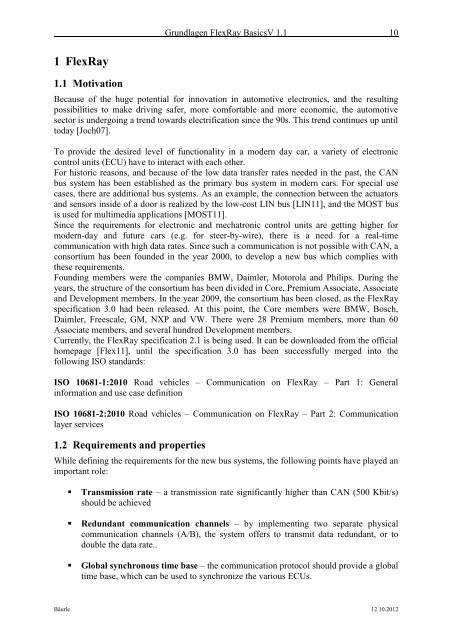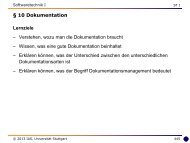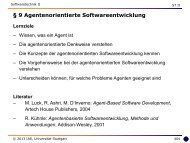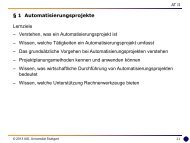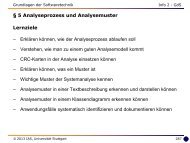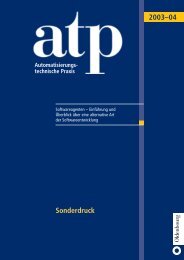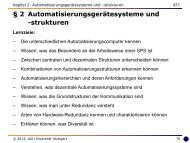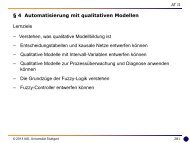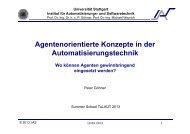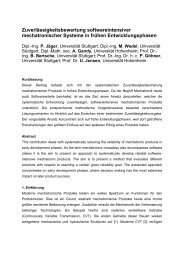Grundlagen FlexRay - Institut für Automatisierungs- und ...
Grundlagen FlexRay - Institut für Automatisierungs- und ...
Grundlagen FlexRay - Institut für Automatisierungs- und ...
You also want an ePaper? Increase the reach of your titles
YUMPU automatically turns print PDFs into web optimized ePapers that Google loves.
<strong>Gr<strong>und</strong>lagen</strong> <strong>FlexRay</strong> BasicsV 1.1 10<br />
1 <strong>FlexRay</strong><br />
1.1 Motivation<br />
Because of the huge potential for innovation in automotive electronics, and the resulting<br />
possibilities to make driving safer, more comfortable and more economic, the automotive<br />
sector is <strong>und</strong>ergoing a trend towards electrification since the 90s. This trend continues up until<br />
today [Joch07].<br />
To provide the desired level of functionality in a modern day car, a variety of electronic<br />
control units (ECU) have to interact with each other.<br />
For historic reasons, and because of the low data transfer rates needed in the past, the CAN<br />
bus system has been established as the primary bus system in modern cars. For special use<br />
cases, there are additional bus systems. As an example, the connection between the actuators<br />
and sensors inside of a door is realized by the low-cost LIN bus [LIN11], and the MOST bus<br />
is used for multimedia applications [MOST11].<br />
Since the requirements for electronic and mechatronic control units are getting higher for<br />
modern-day and future cars (e.g. for steer-by-wire), there is a need for a real-time<br />
communication with high data rates. Since such a communication is not possible with CAN, a<br />
consortium has been fo<strong>und</strong>ed in the year 2000, to develop a new bus which complies with<br />
these requirements.<br />
Fo<strong>und</strong>ing members were the companies BMW, Daimler, Motorola and Philips. During the<br />
years, the structure of the consortium has been divided in Core, Premium Associate, Associate<br />
and Development members. In the year 2009, the consortium has been closed, as the <strong>FlexRay</strong><br />
specification 3.0 had been released. At this point, the Core members were BMW, Bosch,<br />
Daimler, Freescale, GM, NXP and VW. There were 28 Premium members, more than 60<br />
Associate members, and several h<strong>und</strong>red Development members.<br />
Currently, the <strong>FlexRay</strong> specification 2.1 is being used. It can be downloaded from the official<br />
homepage [Flex11], until the specification 3.0 has been successfully merged into the<br />
following ISO standards:<br />
ISO 10681-1:2010 Road vehicles – Communication on <strong>FlexRay</strong> – Part 1: General<br />
information and use case definition<br />
ISO 10681-2:2010 Road vehicles – Communication on <strong>FlexRay</strong> – Part 2: Communication<br />
layer services<br />
1.2 Requirements and properties<br />
While defining the requirements for the new bus systems, the following points have played an<br />
important role:<br />
• Transmission rate – a transmission rate significantly higher than CAN (500 Kbit/s)<br />
should be achieved<br />
• Red<strong>und</strong>ant communication channels – by implementing two separate physical<br />
communication channels (A/B), the system offers to transmit data red<strong>und</strong>ant, or to<br />
double the data rate..<br />
• Global synchronous time base – the communication protocol should provide a global<br />
time base, which can be used to synchronize the various ECUs.<br />
Bäurle 12.10.2012


